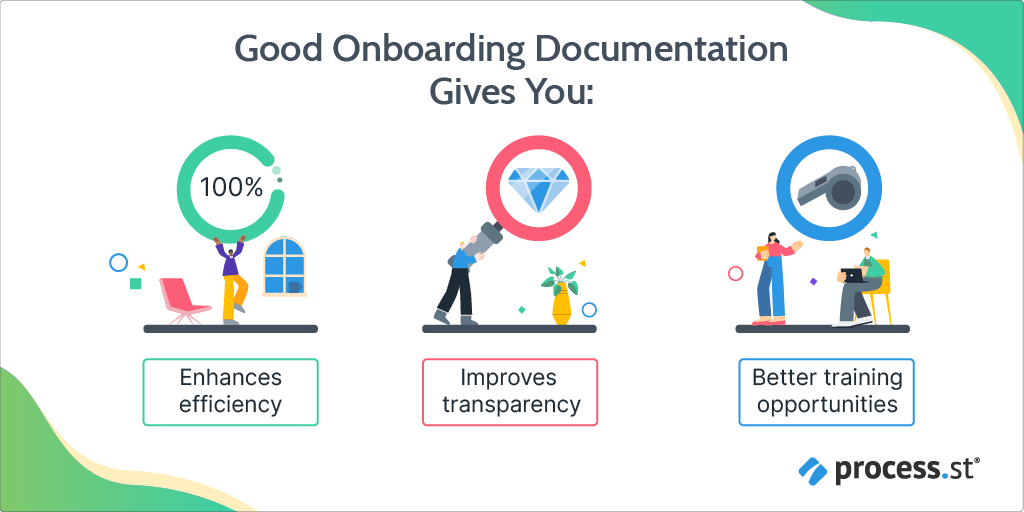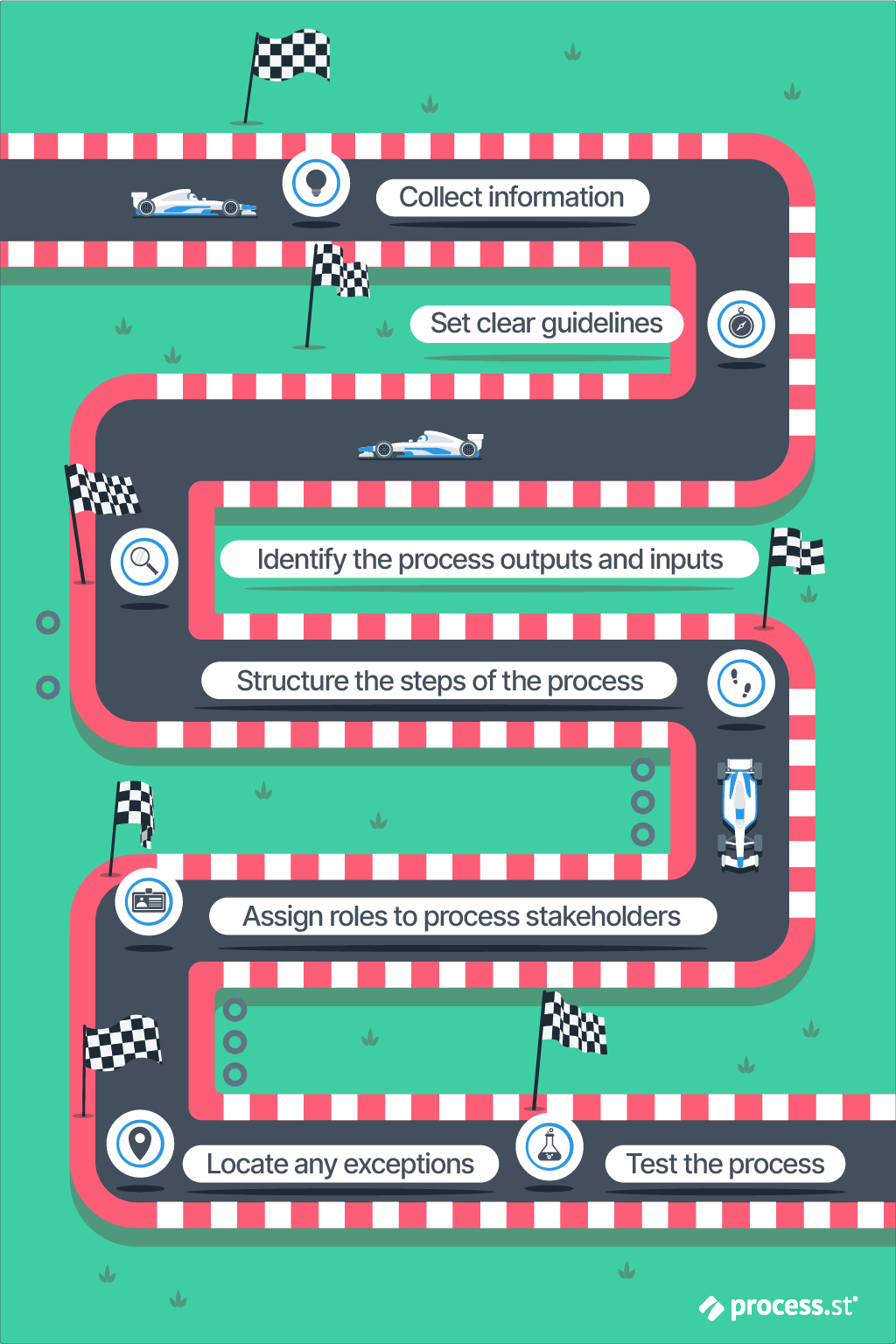
Detailing the exact steps needed in a recurring process – AKA process documentation – seems time-consuming and unnecessarily complicated. After all, it’s something that’s repeated frequently enough that people should know how it’s done, right? WRONG! Take onboarding documentation, for example.
Considering you could be losing anywhere between 20 to 30% of your annual revenue because of inefficiencies, you want your processes to be as lean as possible. Having detailed documentation of a process helps you work more efficiently.
A good onboarding process ensures you can support your new hire through their transition into the company’s culture. That’s how you’re going to build a loyal and productive workforce.
So, in this Process Street article, let’s dive into the 3 ways onboarding documentation can help your new hire. Don’t worry – I’m not just dangling the benefits of onboarding documentation in your face. I’m also walking you through some best practices to reap the benefits.
Here’s what we’re looking at:
- Taking a deeper dive into process documentation
- The importance of having an onboarding documentation process
- How to write onboarding documents: Best practices
- Bringing onboarding documentation to life with Process Street
- Making the process easier with onboarding documentation
Pen and paper at the ready – let’s start documenting!
Taking a deeper dive into process documentation
What exactly is process documentation? Process documentation is taking the time to record exactly how to perform a business procedure.
In this article, we’re specifically looking at onboarding. Onboarding documentation details the series of steps needed to be taken to fully onboard a new employee.
“Without [onboarding] processes, things get missed, mistakes happen, you lose track of work, and your team is inefficient.”
Vinay Patankar, Process Street Co-Founder and CEO
That’s exactly what you want to avoid when welcoming a new employee. Your company’s onboarding experience will be the first impression you give to your new hire; you want it to be a good one.
The importance of having an onboarding documentation process
With a dedicated documentation process, you can set groundwork for what needs to be done and when. Having all your tasks documented also gives you a good view of what can be automated. We LOVE automation because it removes unnecessary tedious repetition (let the computers do the stuff we don’t need to) and reduces human error.
Onboarding documentation leaves your processes organized and gives a clear structure to follow when it comes to actually constructing the template you’re ultimately going to follow. Enforced process control is a byproduct of successful documentation when combining with a modern process tool, like Process Street.
Improvements are also easily facilitated when you combine a process management tool with your documentation. When using Process Street, you can make changes to your processes and have these reflected in real-time. This helps you remain top of your game because you have a process that can be easily adapted to your team’s needs.
But onboarding documentation also has direct benefits for the new hires that are using these processes.

Enhances efficiency with detailed onboarding documentation
Long story short, if you’re documenting your onboarding processes, you’re gaining valuable insight into each part of the process. From here, you can spot what works and what doesn’t.
Overall, you’re empowered to remove any unnecessary steps and clarify anything that might be overly-complicated. The new hires benefit from using these processes that have first been documented.
If your processes are more focused when they have been documented first. That means it works as a good guide for your new hires. They are likely to become more engaged because they know exactly what they need to do.
Efficiency isn’t just about the new hire, either. A well-documented process means anyone can use it and get the same results, so if Sally isn’t at work, Igor can still onboard the new hire and do it right so Sally doesn’t have to go back over the same thing when she comes back.
Every new hire gets the same experience every time, which means they all have the same information and ability to do their jobs the same way – consistency, accuracy, accountability. More consistency and less confusion are a recipe for fewer mistakes. All in all, their efficiency is improved and your company gets to reap the cost-saving benefits of that.
Improves transparency by clearly outlining repeated processes
Onboarding documentation gives you transparency because you know where everything is during the process. When your documentation is used alongside a process management tool, you can track their progress as they complete their tasks.
The series of tasks involved in the onboarding process make it complex and hard to track. But when you’re documenting these onboarding procedures and saving them in centralized and accessible locations, you no longer have confusion surrounding if the new hire did their work correctly.
While this is already a benefit in itself, having transparency comes with some advantages of its own:
- Sharing and communication are encouraged – new hires are likely to feel supported to express their opinions if your management is open about how they want things done.
- Enhanced engagement – transparent tracking allows new employees’ work to be monitored. This empowers management to recognize successes and hard work, as opposed to processes that go unmonitored.
Onboarding documentation highlights better training opportunities
New hires are costly. According to SHRM, you’re looking at approximately $4,425. Those are some big bucks, especially when your new employee isn’t trained enough to actually be adding value to your company yet. Lets not forget they’re taking time away from your experienced talent too.
Okay, we’re not going to throw our poor newbies off our company ship just because they’re eating more than their worth.
How can we get these new hires up and adding value as quickly as possible then?
Process documentation works well as a form of training. When you’re documenting your processes, you’re outlining what’s expected of them, sharing viral information, highlighting the right procedures, and getting them familiar with company standards and policies.
How to write onboarding documentation: Best practices
So you want clear communication and your team aligned? Then writing process documentation well is a must. Onboarding documentation tells your team what they need to do and how to do it.
If your documentation isn’t clear, they aren’t likely going to understand what they need to do, and probably won’t do it as well.
Your dream of having an aligned team that communicates clearly is deader than dead.
You’re paying attention now, huh? Okay, I’ve had my fun.
Your dream is still very much alive and well – as long as you follow these strict steps for writing onboarding documentation. I’m joking again (not really).
Gosh, you’re no fun.
Okay, let’s get to the boring ‘how-to’ section of this post before I quit as a writer and start a career in stand-up comedy.

Step 1: Collect information
Establish the overall idea of the process you want to create. Consider what the process is going to be used for, who will use it, what benefit it has, etc.
Most importantly: Will this process save time and increase efficiency? Or, is it worth the time spent building it?
If you still think it is, identify your primary goals (what is the end result of the onboarding process?) and the timeline you’ll need to complete the process (3 months for a typical onboarding).
Step 2: Set clear guidelines
For each task, determine how it should be completed and who will be responsible for completing it.
It’s important to remember that you should be able to link each task you assign in this onboarding process with the primary goals you want to achieve. For example, assigning the new hire to a mentor would be a task that helped them integrate into the company culture.
Step 3: Identify the process outputs and inputs
Identifying your process outputs and inputs empowers you to break down your primary goals into smaller, bite-sized tasks.
- Process outputs are what you want to gain at the end of the process.
- Process inputs are the resources you require for the process’s completion.
For example, if your objective is to get your new hire working independently, one of your process outputs could be to have them complete a work-related project by themselves that’s evaluated by their respective manager.
Step 4: Structure the steps of the process
Once you have the general shape of your process, it’s time to break it down into a series of steps. Be sure to include a brief explanation for each step so there’s no misunderstanding. Keep each step simple and actionable.
Step 5: Assign roles to process stakeholders
It’s time to assign the task to the employee who’ll be responsible for them. Most onboarding processes involve a basic number of employees: HR, the new hire, the new hire’s manager (of course!), and the new hire’s team members (because teamwork makes the dream work).
Step 6: Locate any exceptions
You’ve got the main understanding of your onboarding process at this point. This is where the fun part comes in: Finding the exceptions.
You set the rules for each task but thanks to He’s Just Not That Into You, we all know there are exceptions to the rules. (P.S. if you don’t know what I’m talking about, I’m seriously disappointed and you need to go watch the movie ASAP).
Not every new hire is the same. You need to accommodate for these discrepancies in your onboarding documentation.
For example, you won’t assign the same project to both a new hire in Sales and a new hire in Engineering. Knowing these exceptions before actually using your onboarding process is going to save a lot of time and confusion, and leave you better prepared.
Process Street has a really neat feature dedicated to these exceptions: Conditional Logic. It intuitively adapts your workflow to the choices you make within specific tasks.
With conditional logic, you can use the same workflow for both your new salesperson and your new engineer. Once you specify which department your new hire is in, the relevant project will show up while all irrelevant tasks are kept hidden.
Step 7: Test the process
The last step is testing the process to make sure it works the way you want it to. When you do these tests, you want to highlight any issues and correct them as you go along to help fine-tune your onboarding process.
Process Street, for example, allows you to create a template of your onboarding process that you can use every time you onboard an employee.
Because it’s all digital and automated, it’s easy to make changes directly to the workflow and have all active workflows updated immediately.
Now, think about how long it’d take you to go through and manually update 5,237 onboarding workflows individually. Any issues you discover and fix within the workflow will reflect immediately for both current and future processes.
Bringing onboarding documentation to life with Process Street
Writing onboarding documentation is worthless if it’s not easy to maintain and actionable.
So why did I just present you with seven steps to writing onboarding documentation if I’m now also telling you it’s worthless?
Good documentation sets a good foundation for you to build your process on. But it’s just that: a foundation.
Process Street’s dynamic workflows and centralized knowledge base are where the magic happens.
Process Street is intuitive and makes it easy for you to make changes to your onboarding processes on the fly without breaking anything. Not to mention, we’ve got tons of features that help make your process actionable, like:
- Stop tasks: Enforces process control with tasks that need to be completed before the workflow can continue.
- Dynamic due dates: Lets you set a deadline based on the completion or start of other tasks within the same workflow, so the work you need gets done at a time most accurate for your team’s needs.
- Conditional logic: Uses branching logic to create processes that adapt based on information and choices in a specific workflow for a more personalized onboarding experience.
- Role assignments: Assign team members to tasks based on their role in the onboarding process, letting your processes stay accurate even if the person in that role changes.
- Approvals: These tasks let you stop a workflow in place until a decision-maker has reviewed and either approved or rejected the work completed so far; they can also give comments as feedback.
- Automations: All recurring tasks can be automated to reduce human input, saving time and helping new hires and their team focus on the work that needs their attention instead.
Now, before any of these features can be implemented, you’ve got to plan the process. Well, that’s kind of what I’ve been saying the whole time.
I’ve spoken to you about how you can write onboarding documentation. Now I’m going to show you where you can do it: Pages. Think of it as your go-to-place for all your planning. And best of all, it lives alongside your workflows, helping you understand the process you want to construct.
Making the process easier with onboarding documentation
Think of process documentation as a journey. If you have a roadmap, you can find the route that’ll get you there the quickest.
Documenting all the tasks needed to complete a process can help you see where steps can be automated and streamlined, making your company more agile and efficient. Who wouldn’t want that?
But you need to know how to read a map to know where you’re going, just like you need to know how to write onboarding documentation to get everything laid out in front of you. Then comes the fun part: Using process management software, like Process Street, to bring your documentation to life.
When your onboarding processes are alive and thriving, you’re giving your new employees the help they need to start adding value to your company quickly. Not to mention, they feel supported and excited to do it.
What benefit do you like most about process documentation? Is it something you do before creating a business process? Let us know in the comments below!







 Workflows
Workflows Projects
Projects Data Sets
Data Sets Forms
Forms Pages
Pages Automations
Automations Analytics
Analytics Apps
Apps Integrations
Integrations
 Property management
Property management
 Human resources
Human resources
 Customer management
Customer management
 Information technology
Information technology



Grace Donaldson
Grace is a content writer with a thirst for knowledge and coffee. You'll find her reading in a small café or singing at a rundown jazz bar when she's not overconsuming coffee or compartmentalizing her thoughts into a blog post.